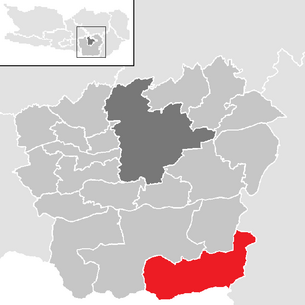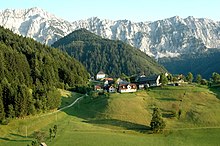Zell (Carinthia)
|
Cell
sele |
||
|---|---|---|
| coat of arms | Austria map | |
|
|
||
| Basic data | ||
| Country: | Austria | |
| State : | Carinthia | |
| Political District : | Klagenfurt-Land | |
| License plate : | KL | |
| Main town : | Zell parish / Sele-Fara | |
| Surface: | 75.44 km² | |
| Coordinates : | 46 ° 28 ' N , 14 ° 23' E | |
| Height : | 948 m above sea level A. | |
| Residents : | 611 (January 1, 2020) | |
| Population density : | 8.1 inhabitants per km² | |
| Postal code : | 9170 | |
| Area code : | 04227 | |
| Community code : | 2 04 41 | |
| NUTS region | AT211 | |
| Address of the municipal administration: |
9170 Zell-Pfarre / Sele-Fara 75 | |
| Website: | ||
| politics | ||
| Mayor : | Heribert Kulmesch ( SPÖ ) | |
|
Municipal Council : ( 2015 ) (11 members) |
||
| Location of Zell Sele in the Klagenfurt-Land district |
||
| Source: Municipal data from Statistics Austria | ||
Zell , in Slovenian Sele , is a bilingual community with 611 inhabitants (as of January 1, 2020) in the Klagenfurt-Land district in Carinthia, in the north of the Karawanken Mountains .
geography
Geographical location
Zell is located in a secluded side valley on the north side of the Karawanken on the Slovenian - Austrian border, about 20 km south of Klagenfurt and 6 km south of Ferlach . The altitude of the municipality is between 587 m (at the confluence of the Ribnitza with the Waidischbach) and 2139 m ( Hochobir ). The main settlement area on the valley floor, which runs in an east-west direction, is at an altitude of approximately 950 m .
Zell is framed by the following mountains: Ferlacher Horn ( Grlovec , 1840 m ) and Freiberg ( Setiče , 1923 m ) in the north, Hochobir ( 2139 m ) and Kuhberg ( Kravji vrh , 2025 m ) in the east and Koschuta ( Košuta ) with the Koschutnikturm (Košutnikov turn, 2136 m ) in the south. The Koschuta also forms the border with Slovenia. Part of the Freibach reservoir, which was created in 1958 by Kelag to generate electricity, is located in the municipality of Zell. Before it was dammed, there were a few houses and saws in this area on the Freibach, which you can still see today at low tide.
Community structure
Zell is divided into the three cadastral communities of Zell im Winkel ( Sele v Kotu ), Zell near the parish ( Sele pri Cerkvi ) and Zell near Sonnegg ( Sele pri Ženeku ). The municipality includes the following 7 localities (population as of January 1, 2020):
- Zell-Freibach ( Sele-Borovnica ) (152)
- Zell-Homölisch ( Sele-Homeliše ) (17)
- Zell-Koschuta ( Sele-Košuta ) (0)
- Zell-Mitterwinkel ( Sele-Srednji Kot ) (64)
- Cell upper angle ( Sele-Zvrhnji Kot ) (65)
- Zell parish ( Sele-Cerkev , also Sele-Fara ) (204)
- Zell-Schaida ( Sele-Šajda ) (109)
Further districts are the hamlet Dražja vas and the Rotte Kobla .
Neighboring communities
| Ferlach | Sankt Margareten im Rosental | Gallicia |
| Ferlach |

|
Eisenkappel-Vellach |
| Tržič |
history
Zell-Mitterwinkel and Zell Oberwaidisch were probably the first two parts of the municipality to have been settled during the 11th century. It is believed that the first church was built around 1200. A few decades later, Cel was mentioned for the first time in a document (1280). A small bell dates back to 1364, the year in which the people of Zell were given their own cemetery. Associated with this was the right to the dispensing of the sacraments and a weekly church service by the chaplain from Kappel an der Drau, a five-hour walk away . In 1492, today's municipal area was crossed by Ottoman troops. In 1524 the oldest surviving "Hollenburger Urbar " reported 43 yards in Zell. In 1630 the managers of two farms in the Sonnegger area (Meležnik and Kališnik) were mentioned as the first free farmers.
From 1732 to 1733, however, the people of Zell built a parsonage at their own expense on the grounds of the Hollenburg estate . In 1787 Zell was raised to an independent parish, the formation of the local parish of Zell from the cadastral parishes of Zell bei der Pfarre, Zell bei Sonnegg and Zell im Winkel followed in 1850. The reorganization of the Austrian state in 1848 meant that the local residents were able to elect a mayor for the first time. The first mayor was Ogris Thomas. The primary school was opened under Mayor Janko Kelich, who was elected in 1895. The lessons took place until the opening of a school building in the dance hall of the Gasthaus Maschey (Zell Pfarre No. 13). Lessons were given in one class and bilingual (utraquistic) in Slovenian and German. In 1895, Kelich introduced the Slovene language as the language of the municipal office. Before that, official business was dealt with exclusively in German. In 1908 the country mail carrier came to Waidisch and Zell, where letter boxes were set up in suitable places.
In the Carinthian referendum of 1920 , the residents of Zell voted with 97% for annexation to Yugoslavia. In the first years after the " Anschluss of Austria " in March 1938, according to National Socialist estimates, around 20 Zellaner "deserters" fled to Slovenia, but returned after the German invasion of Yugoslavia in April 1941 and lived in stables, barns and bunkers. The main members of the resistance group were Thomas, Johann, Peter and Valentin Olip, Jernej and Jakob Orasche (Oraže), Franc Pristovnik and the brothers Florjan and Urh Kelih. After the storming of the bunker at the Hlipoutschnik (Hlipovčnik) saw on December 2, 1942, on April 16, 1943 the Klagenfurt Regional Court "for preparation for high treason" was tried before the People's Court under the Nazi blood judge who had traveled from Berlin especially for this purpose Roland Freisler , in which 12 men, including 7 from Zell, as well as Maria Olip , who also comes from Zell, were sentenced to death, declared "forever dishonorable" and executed on April 29, 1943 in Vienna. The 17-year-old Janez Oraže was also among those executed .
A rock fall was observed on July 5, 2012. Several 1000 m³ of rock had broken out of the north face of the Koschuta massif.
population
According to the 2001 census, the community of Zell had 703 inhabitants. 89.1% of them stated Slovene as the colloquial language, 9.1% were German-speaking. Zell is thus the municipality with the highest proportion of Carinthian Slovenes and at the same time the only municipality with a predominantly Slovenian-speaking population. 98.4% of the population have Austrian citizenship.
98.1% of the community population profess to the Roman Catholic Church , 1.7% of the population are without religious beliefs.
Culture and sights
- Parish church of Sankt Ulrich , first mentioned in a document in 1364
Zell / Sele has been part of the Bergsteigerdörfer -Initiative of the PES since 2013 , which aims to promote sustainable tourism in accordance with the Alpine Convention .
politics
In the 2008 National Council elections , Zell had the highest percentage of voters for the LIF in all of Austria with 25.3% and at the same time the lowest percentage for the FPÖ with 0.7% .
The 2017 National Council election in Zell brought 50.75% of the votes for the SPÖ , 22.52% for the ÖVP and 7.81% for the FPÖ.
Municipal council
The municipal council has 11 members and has been composed as follows since the 2015 municipal council election :
The directly elected mayor is Heribert Kulmesch (SPÖ).
coat of arms
The municipality's coat of arms symbolizes the silhouette of the Koschuta massif, which forms the southern border of the municipality, with the Kotschutnikturm as the highest peak. The coat of arms and flag were awarded to the municipality on June 26, 1995, the flag is green and white with an incorporated coat of arms.
Personalities
- Gustav Januš (* 1939), writer, painter and teacher
- Thomas Olip (1913–1943), resistance fighter against National Socialism
- Jakob Oraže (1902–1943), resistance fighter against National Socialism
- Franc Pristovnik (1910–1943), resistance fighter against National Socialism
- Janez Oraže (1925–1943), resistance fighter against National Socialism
- Jernej Oraže (1902–1943), resistance fighter against National Socialism
- Florjan Kelih (1908–1943), resistance fighter against National Socialism
- Urh (Ulrich) Kelih (1912–1943), resistance fighter against National Socialism
literature
- Hans M. Tuschar: Zell / Sele - heart of the Karawanken. Johannes Heyn , Klagenfurt 1993, ISBN 3-85366-731-7 .
- Hans M. Tuschar / Egon Wassner: Zell - Sele, Austrian Alpine Association, Innsbruck 2013, ( online )
Web links
- Zell municipality (German and Slovenian)
- Mountaineering village of Zell-Sele
- 20441 - Zell (Carinthia). Community data, Statistics Austria .
Individual evidence
- ↑ Hans M. Tuschar: Zell / Sele-Herz der Karawanken / Srce Karavank . Johannes Heyn, Klagenfurt 1993, ISBN 3-85366-731-7 , p. 274 (288 pp.).
- ↑ Statistics Austria: Population on January 1st, 2020 by locality (area status on January 1st, 2020) , ( CSV )
- ↑ Hans M. Tuschar: Zell / Sele-Herz der Karawanken / Srce Karavank . Johannes Heyn, Klagenfurt 1993, ISBN 3-85366-731-7 , p. 12 (288 pp.).
- ↑ Evelin Pirker, Dietmar Wanko: Das Rosental . Styria, Graz, Vienna, Cologne 1997, pp. 48 (31 pp.).
- ↑ Hans M. Tuschar: Zell / Sele-Herz der Karawanken / Srce Karavank . Johannes Heyn, Klagenfurt 1993, ISBN 3-85366-731-7 , p. 23 (288 pp.).
- ↑ Hans M. Tuschar: Zell / Sele-Herz der Karawanken / Srce Karavank . Johannes Heyn, Klagenfurt 1993, ISBN 3-85366-731-7 , p. 20 (288 pp.).
- ↑ Hans M. Tuschar: Zell / Sele-Herz der Karawanken / Srce Karavank . Johannes Heyn, Klagenfurt 1993, ISBN 3-85366-731-7 , p. 54 (288 pp.).
- ↑ Hans M. Tuschar: Zell / Sele-Herz der Karawanken / Srce Karavank . Johannes Heyn, Klagenfurt 1993, ISBN 3-85366-731-7 , p. 21 (288 pp.).
- ↑ Postal matters. In: Free Voices. German Kärntner Landes-Zeitung / Free votes. Southern German-Alpine daily newspaper. Deutsche Kärntner Landeszeitung , May 2, 1908, p. 5 (right column, middle) (online at ANNO ).
- ↑ August Walzl: Against National Socialism. Resistance to Nazi rule in Carinthia, Slovenia and Friuli. Carinthia, Klagenfurt 1994, ISBN 3-85378-410-0 , p. 84, p. 285, notes 51, 52.
- ↑ August Walzl: Against National Socialism. P. 107 f.
- ^ Rockslide in the Koschutamassiv orf.at, July 5, 2012, accessed August 27, 2017.
- ↑ Statistics Austria. (PDF; 10 kB) Municipality of Zell: Demographic data / colloquial language
- ↑ The Carinthian municipality of Zell-Sele - small but nice. Zell-Sele municipality, accessed on November 8, 2018 .
- ↑ Election result ( memento of the original from October 1, 2008 in the Internet Archive ) Info: The archive link was inserted automatically and has not yet been checked. Please check the original and archive link according to the instructions and then remove this notice. , BMI, accessed October 6, 2008.
- ↑ National Council election 2017 - news.ORF.at. Retrieved April 26, 2018 .








